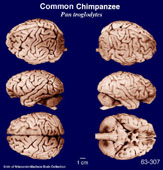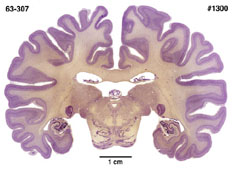|
Common
Chimpanzee
(Pan troglodytes) #63-307 |
||||
|
|
Physical
characteristics and distribution
|
|
The face of adults is typically black, or mottled with brown. Hair is black to brown, and there is no underfur present. There may be some white hairs around the face (looking a bit like a white beard in some individuals). Infants have a white tuft of hair on their rumps, which identifies their age quite clearly. This white tail tuft is lost as an individual ages. Individuals of both sexes are prone to lose the hair on the head as they age, producing a bald patch behind the brow ridge. Graying of hairs in the lumbar region and on the back is common with age, also. Adults have a head and body length ranging between 635 and 925 mm. When standing erect, they are 1 to 1.7 m tall. In the wild, males weigh between 34 and 70 kg, whereas females are slightly smaller, weighing between 26 and 50 kg. The arms are long, such that the spread of the arms is 1.5 times the height of an individual. Legs are shorter than are the arms, which allows these animals to walk on all fours with the anterior portion of the body higher than the posterior. They have very long hands and fingers, with short thumbs. This hand morphology allows them to use their hands as ³hooks² while climbing, without interference from the thumb. Common Chimpanzees are broadly omnivorous. They rely heavily on ripe fruits and young leaves, with additional consumption of stems, buds, bark, pith, seeds, and resins. This diet is supplemented by a variety of insects, small vertebrates, and eggs. Soil is sometimes consumed, especially that associated with termite mounds, presumably for the minerals it contains. Diets vary seasonally, as different foods are available at different times of year. Females have an estrus cycle which lasts approximately 36 days. During the course of this cycle, as her hormone levels change, a female experiences changes is the size, shape, and color of her genital skin. As circulating estrogens increase during the follicular phase of the cycle, the size of the swelling increases. When the anogenital skin is fully engorged, it is typically bright pink, and can measure from 938 to 1400 cc. The state of maximal tumescence is of variable length in different individuals and at different stages of maturity, but lasts an average of 6.5 days. It is during this time that females are sexually receptive and that the bulk of copulations with mature males occur. They utilize a great diversity of habitat types. Although they are typically thought of as living in tropical rainforests, they are also found in forest-savanna mosaic environments, as well as in montain forests at elevations up to 2,750 m. Some populations are known to inhabit primarily savanna habitat. Most Pan troglodytes inhabit the tropical forests of central Africa. There are three recognized subspecies of Common Chimpanzee. They are found in S Cameroon; Gabon; S Republic of Congo; Uganda; W Tanzania; E and N Dem. Rep. Congo; W Central African Republic; Guinea to W Nigeria, south to Congo River in W Africa. |
|
Description
of the brain
|
|
Animal
source and preparation
|
|
All
specimens collected followed the same preparation
and histological procedure.
|
Other Related Resources (websites and publications)
List of Specimens | Explore Collections | Brain Sections | Brain Evolution | Brain Development | Brain Circuitry | Brain Functions | Location and Use | Related Web Sites | Contact Us | Search MSU Database | Personnel | Home



